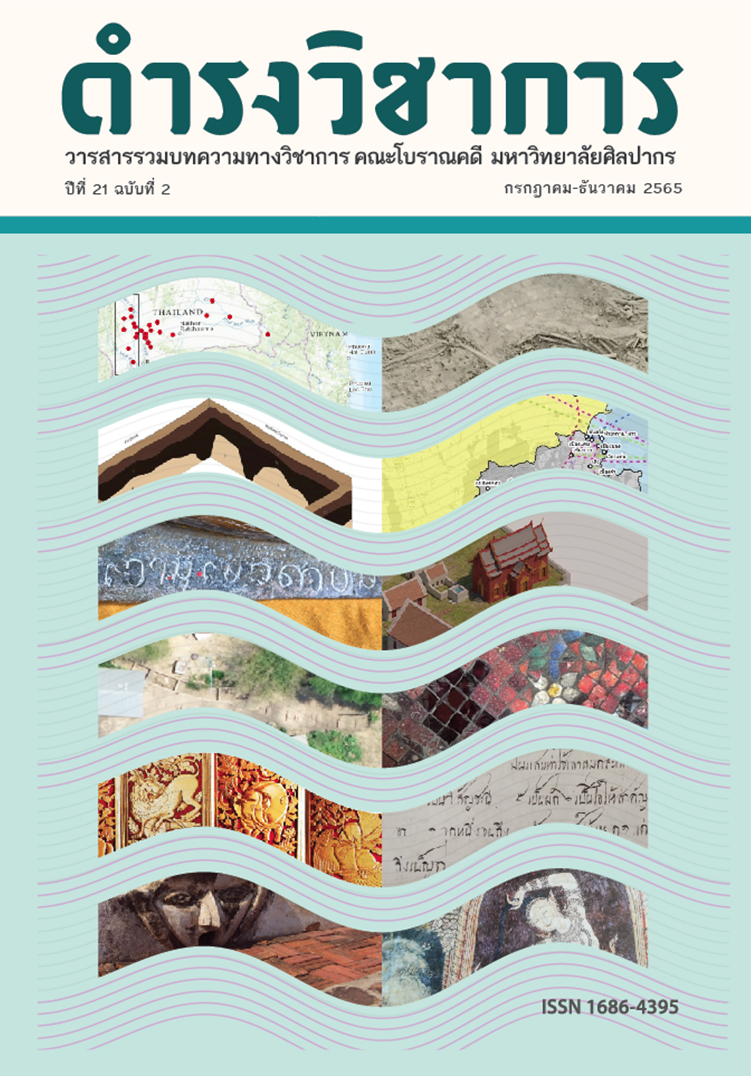The Presumption of Early Settlement Periods in Pattani: Findings from Archaeological Excavation at Tanyonglulo Site
Keywords:
Yarang, ancient Pattani, archaeological evidences, excavation, the settlement, portAbstract
This paper reports findings of the study on the early occupation of modern day Pattani. The study presumed the early periods of settlement correspond to archaeological data from excavation at Tanyonglulo. Two periods of time came up for discussion in terms of land use in two main areas of Pattani: the Ancient Town of Yarang and Krue Se Village. The Ancient Town of Yarang was geographically located inland, in what is regarded as the upper delta plain of the Pattani River. According to ancient historical texts and archaeological evidence, Yarang was likely a polity of the Kingdom of Langkasuka. Available evidence suggests that the golden age of Yarang was between the 6th and 18th centuries CE.
The Krue Se Village is located on the lower delta plain of the Pattani River. Krue Se was the center where the Pattanian lived and spent their daily lives. Situated near the sea, Krue Se became a port and an international trading hub in the Ayutthaya period. The community was predominantly ruled by the Sri Wangsa Dynasty. None of previous studies gave a report on the existence of the community prior to the rule of the Sri Wangsa dynasty. The documentary analysis and archaeological discoveries about the sites revealed that Krue Se Village, or the ancient Pattani, was a community and people actively engaged in trading with foreigners before the rule of Sri Wangsa dynasty. A retrospective study of the history of Krue Se Village should acknowledge that its existence is thought to be contemporary with the ancient town of Yarang, whose habitation area and the port itself was presumably at Bra-O at least until the 12th century.
References
ภาษาไทย
กรมศิลปากร, 2528. รายงานการสำรวจขุดค้นทางด้านโบราณคดี บริเวณเมืองโบราณยะรังและใกล้เคียง
อำเภอยะรัง จังหวัดปัตตานี. ม.ป.ท.
________, 2546. ศูนย์ข้อมูลเมืองโบราณยะรัง อำเภอยะรัง จังหวัดปัตตานี. กรุงเทพฯ: ไทยเจริญเพลส.
________, 2562. การสำรวจและขุดค้นแหล่งโบราณคดีในพื้นที่จังหวัดนครศรีธรรมราช ประเทศไทย. ม.ป.ท.
________, 2565.การขุดค้นโบราณคดี ณ วัดพระมหาธาตุวรมหาวิหาร นครศรีธรรมราช. พิมพ์ครั้งที่ 2. นครศรีธรรมราช: สำนักศิลปากรที่ 12 นครศรีธรรมราช กรมศิลปากร.
ทิวา ศุภจรรยา และกฤษณพล วิชพันธุ์, 2538. สภาพแวดล้อมการตั้งถิ่นฐานชุมชนโบราณเมืองยะรัง จังหวัดปัตตานี. กรุงเทพฯ: การประชุมวิชาการระดับชาติฝรั่งเศส-ไทย ครั้งที่ 3 เรื่อง พัฒนาการของรัฐในประเทศไทยจากหลักฐานทางโบราณคดี, 11-13 ธันวาคม 2538.
ธราพงศ์ ศรีสุชาติ, 2529. “ยะรัง: ชุมชนโบราณ.” ใน สารานุกรมวัฒนธรรมภาคใต้ (หน้า 2900-2905). สงขลา: สถาบันทักษิณคดีศึกษา.
พรทิพย์ พันธุโกวิท, 2547. “การศึกษาวิเคราะห์โบราณสถานเมืองยะรัง: ศึกษากรณีกลุ่มโบราณสถานบ้านจาเละ อำเภอยะรัง จังหวัดปัตตานี.” ใน วันนี้ของโบราณคดีไทย เอกสารประกอบการประชุมสัมมนาทางวิชาการโบราณคดี. กรุงเทพฯ : สำนักโบราณคดี กรมศิลปากร.
ภมรี สุรเกียรติ, 2565. ผู้ช่วยศาสตราจารย์ มหาวิทยาลัยสงขลานครินทร์. สัมภาษณ์, 20 ตุลาคม.
ภัคพดี อยู่คงดี และพรทิพย์ พันธุโกวิท, 2538. โบราณสถานวัตถุจากการขุดแต่งโบราณสถานบ้านจาเละ กลุ่มเมืองโบราณยะรัง อำเภอยะรัง จังหวัดปัตตานี. กรุงเทพฯ: การประชุมวิชาการระดับชาติฝรั่งเศส-ไทย ครั้งที่ 3 เรื่อง พัฒนาการของรัฐในประเทศไทยจากหลักฐานทางโบราณคดี, 11-13 ธันวาคม 2538.
ยงยุทธ ชูแว่น, 2549. รัฐปัตตานีในประวัติศาสตร์เอเชียตะวันออกเฉียงใต้สมัยจารีต คริสต์ศตวรรษที่ 16-18. นครปฐม: โรงพิมพ์มหาวิทยาลัยศิลปากร.
สว่าง เลิศฤทธิ์, 2529. “ข้อเสนอใหม่เกี่ยวกับแหล่งโบราณคดีบริเวณเมืองเก่ายะรัง ปัตตานี.” ศิลปวัฒนธรรม. 7 (12): 32-35.
________, 2530. รายงานการขุดค้นแหล่งโบราณคดี บ้านประแว อำเภอยะรัง จังหวัดปัตตานี. ปัตตานี: ศูนย์การศึกษาเกี่ยวกับภาคใต้ มหาวิทยาลัยสงขลานครินทร์ วิทยาเขตปัตตานี.
________, 2531. “โบราณสถาน โบราณวัตถุ ศิลปะ.” ใน เมืองโบราณยะรัง (หน้า 27-38). ปัตตานี: ศูนย์การศึกษาเกี่ยวกับภาคใต้.
สำนักงานราชบัณฑิตยสภา, 2561. หลักเกณฑ์การทับศัพท์ภาษาพม่าฉบับราชบัณฑิตยสภา. กรุงเทพฯ: สำนักงานราชบัณฑิตยสภา.
________, 2562. หลักเกณฑ์การทับศัพท์ภาษาญี่ปุ่นฉบับราชบัณฑิตยสภา. กรุงเทพฯ: สำนักงานราชบัณฑิตยสภา.
________, 2563. หลักเกณฑ์การทับศัพท์ภาษามลายูที่ใช้ในประเทศมาเลเซีย สิงคโปร์ และบรูไนดารุสซาลามฉบับราชบัณฑิตยสภา. กรุงเทพฯ: สำนักงานราชบัณฑิตยสภา.
อมรา ศรีสุชาติ, 2539. อดีต-ปัจจุบันของเตาเผาเครื่องปั้นดินเผาโบราณและพื้นเมืองในภาคใต้. ม.ป.ท.
อัตถสิทธิ์ สุขขำ, 2557. “เครื่องปั้นดินเผากลาสโกวในเมืองปัตตานี.” เมืองโบราณ 40 (1): 68-74.
อารีฟิน บินจิ, อับดุลลอฮ์̣ ลออแมน, และซูฮัยมีย์ อิสมาแอล, 2558. ปาตานี ประวัติศาสตร์และการเมืองในโลกมลายู (Patani Sejarah dan Politik di Alam Melayu). พิมพ์ครั้งที่ 4. สงขลา: มูลนิธิวัฒนธรรมอิสลามภาคใต้.
อำนาจ สมบัติยานุชิต, 2547. การศึกษาบริเวณแหล่งเตาเผาเครื่องถ้วยโบราณในจังหวัดปัตตานี. ม.ป.ท.
อิบรอฮิม ชุกรี, 2541. ประวัติราชอาณาจักรมลายูปะตานี. ปัตตานี: โครงการจัดตั้งสถาบันสมุทรรัฐเอเชียตะวันออกเฉียงใต้ศึกษา.
ภาษาต่างประเทศ
Daniel P. et al., 2005. Études sur l'histoire du sultanat de Patani. Paris: Ecole française d'Extrême-Orient.
Dupoizat M.-F., 2004. “Gres et porcelains du site de Ban Kru Se, province de Pattani.” In Etudes sur l’histoire du sultanat de Patani (pp.117-139). Paris: École française d'Extrême-Orient.
Hirth F. & Rockhill W.W., 1966. Chau Ju Kua: his work on the Chinese and Arab Trade in the twelfth and thirteenth Centuries, entitled Chu-fan-chi. New York: Paragon Book Reprint Corp.,
SEAMEO SPAFA., 2020. “Thailand: Country Report.” In Advancing Southeast Asian Archaeology 2019 (pp. 40-46). Bangkok: SEAMEO SPAFA Regional Centre for Archaeology and Fine Arts.
Skilling P., 1992. “Two ports of Suvarnabhumi : A brief note.” Journal of Siam Society 80 (1): 131.
Teeuw A. & Wyatt D.K, 1970. Hikayat Patani: The Story of Patani. The Hague: Martinus Nijhoff.
Wade G., 2013. “The Patani region in Chinese texts of the 6th to the 19th centuries." In Ghost of the past in Southern Thailand: Essay on the history and historiography of Patani (pp.53-84). Singapore: NUS Press.
Welch D.J. & Mcneill J.R., 1989. “Archaeological investigations of Pattani history.” Journal of Southeast Asian Studies 20 (1): 27-41.
Wheatley P., 1973. The Golden Khersonese. USA: Greenwood Press.
Yoneo I., 1998. The junk trade from Southeast Asia. Singapore: Institute of Southeast Asia.
________, 2004. “A note on Pattani recorded in late 17th and early 17th century Japanese documents.” In E’tudes sur l’histoire du Sultanant de Patani (pp. 255-257) Paris: École française d'Extrême-Orient.
Yoshinobu S., 1983. “Sung foreign trade: Its scope and organization.” In China among eguals: The middleman kingdom and its neighbors 10-14 centuries (pp. 89-114). California: University of California Press.
Downloads
Published
Issue
Section
License
Copyright (c) 2022 Damrong Journal of The Faculty of Archaeology Silpakorn University

This work is licensed under a Creative Commons Attribution-NonCommercial-NoDerivatives 4.0 International License.
บทความนี้เป็นผลงานของข้าพเจ้าแต่เพียงผู้เดียว และ/หรือเป็นผลงานของข้าพเจ้าและผู้ร่วมงาน ตามชื่อที่ระบุในบทความจริง และเป็นผลงานที่มิได้ถูกนำเสนอหรือตีพิมพ์ที่ใดมาก่อน





